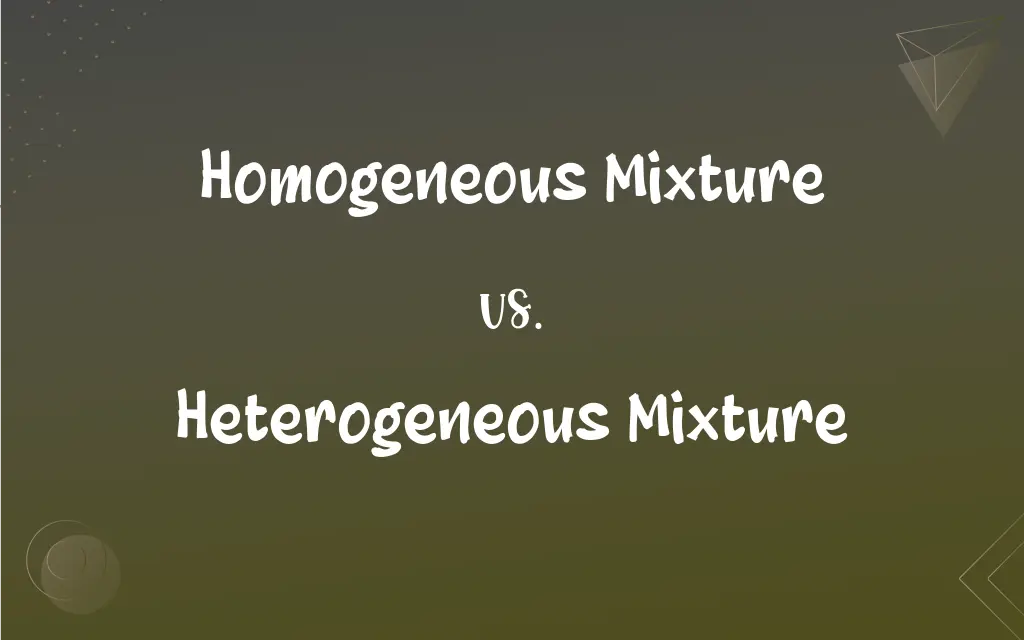Homogeneous Mixture vs. Heterogeneous Mixture: What's the Difference?
Edited by Janet White || By Harlon Moss || Updated on October 9, 2023
A homogeneous mixture has uniformly distributed components; a heterogeneous mixture has visibly distinct parts.

Key Differences
In the world of chemistry, mixtures play an essential role, and understanding their nature is crucial. A homogeneous mixture is a type of mixture wherein the components are uniformly distributed. In such a mixture, the individual constituents are not visually distinguishable. Solutions, where solutes are dissolved in solvents, exemplify homogeneous mixtures. For instance, when salt is completely dissolved in water, it forms a homogeneous mixture where the salt is uniformly spread throughout the solution.
Conversely, a heterogeneous mixture is characterized by the presence of visibly distinguishable components. In such mixtures, the individual substances remain distinct and can often be separated physically. For example, a salad with different vegetables is a typical heterogeneous mixture, as one can see and separate each vegetable from the mixture.
While both homogeneous mixtures and heterogeneous mixtures comprise multiple substances, the key difference lies in the distribution of these substances. In a homogeneous mixture, this distribution is even, and the mixture exhibits consistent properties throughout. On the other hand, a heterogeneous mixture displays non-uniformity, with its components often settling in layers or clumps.
In applications, the distinction between homogeneous mixtures and heterogeneous mixtures is vital. For instance, manufacturers ensure certain products, like lotions or beverages, are homogeneous to guarantee consistent quality and properties throughout the product. Meanwhile, certain design elements might intentionally employ heterogeneous mixtures for aesthetic or functional purposes, like granite countertops displaying a medley of different mineral grains.
Comparison Chart
Uniformity
Uniform distribution
Non-uniform distribution
ADVERTISEMENT
Visual Distinction
Components not distinguishable
Components are distinguishable
Examples
Saltwater, air
Sand and salt mix, salad
Separation
Hard to separate without chemical processes
Often separated through physical means
Applications
Beverages, lotions
Granite countertops, cereals
Homogeneous Mixture and Heterogeneous Mixture Definitions
Homogeneous Mixture
A solution with undistinguishable substances.
Sugar dissolved in water forms a homogeneous mixture.
ADVERTISEMENT
Heterogeneous Mixture
Combination displaying varied properties in different regions.
A chocolate chip cookie dough is a heterogeneous mixture with distinct chips.
Homogeneous Mixture
Mixture exhibiting consistent properties throughout.
A cup of coffee is a homogeneous mixture when the sugar is fully dissolved.
Heterogeneous Mixture
A mix easily separated into individual substances.
In a heterogeneous mixture of sand and salt, one can separate the sand by sieving.
Homogeneous Mixture
A blend with evenly distributed components.
Air is a homogeneous mixture of various gases.
Heterogeneous Mixture
A blend with visibly distinct parts.
A bowl of fruit salad is a heterogeneous mixture.
Homogeneous Mixture
A mix where separation of components is challenging.
The components of a homogeneous mixture of ethanol and water are hard to separate.
Heterogeneous Mixture
A mixture where substances remain separate.
Oil and water form a heterogeneous mixture when combined.
Homogeneous Mixture
A single-phase combination of substances.
A metal alloy is a homogeneous mixture of different metals.
Heterogeneous Mixture
Multi-phase composition of components.
A bottle of sand and iron filings is a heterogeneous mixture.
FAQs
Can a salad be seen as a homogeneous mixture?
No, a salad with different ingredients is a heterogeneous mixture.
How can you visually identify a heterogeneous mixture?
A heterogeneous mixture has visibly distinct parts or layers.
Is the air we breathe homogeneous or heterogeneous?
The air we breathe, comprising various gases, is a homogeneous mixture.
Are homogeneous mixtures always transparent?
No, homogeneous mixtures can be transparent, translucent, or opaque, depending on their composition.
Is a soft drink a homogeneous mixture?
Once carbonated and flavored, a soft drink is typically a homogeneous mixture.
Is granite a homogeneous or heterogeneous mixture?
Granite, with its visibly different mineral grains, is a heterogeneous mixture.
Are all solutions considered homogeneous mixtures?
Yes, solutions where solutes dissolve uniformly in solvents are homogeneous mixtures.
Are alloys like bronze considered homogeneous mixtures?
Yes, bronze, an alloy of copper and tin, is a homogeneous mixture.
Can the presence of clumps indicate a heterogeneous mixture?
Yes, clumps or visible distinctions usually signify a heterogeneous mixture.
Are homogeneous mixtures always in the liquid phase?
No, homogeneous mixtures can be in solid, liquid, or gas phases.
Can a mixture change from homogeneous to heterogeneous?
Yes, changes in temperature or composition can transition a mixture between states.
What's a defining feature of a homogeneous mixture?
A homogeneous mixture has uniformly distributed components.
Why are certain drinks like cocktails considered heterogeneous?
Cocktails can have layers or chunks of fruits, making them heterogeneous mixtures.
Can a mixture be both homogeneous and heterogeneous?
No, a mixture is either homogeneous or heterogeneous based on component distribution.
Is fog considered a homogeneous mixture?
No, fog, a mix of air and water droplets, is heterogeneous.
Can a milkshake with chunks of fruit be homogeneous?
No, a milkshake with visible fruit chunks is a heterogeneous mixture.
Is it easier to separate components of a homogeneous or heterogeneous mixture?
Components of a heterogeneous mixture are often easier to separate physically.
What's an example of a solid heterogeneous mixture?
A chocolate chip cookie is a solid heterogeneous mixture.
How does gravity affect heterogeneous mixtures?
In heterogeneous mixtures, heavier components can settle at the bottom due to gravity.
Can homogeneous mixtures have varying concentrations?
Yes, homogeneous mixtures can vary in concentration but remain uniform.
About Author
Written by
Harlon MossHarlon is a seasoned quality moderator and accomplished content writer for Difference Wiki. An alumnus of the prestigious University of California, he earned his degree in Computer Science. Leveraging his academic background, Harlon brings a meticulous and informed perspective to his work, ensuring content accuracy and excellence.
Edited by
Janet WhiteJanet White has been an esteemed writer and blogger for Difference Wiki. Holding a Master's degree in Science and Medical Journalism from the prestigious Boston University, she has consistently demonstrated her expertise and passion for her field. When she's not immersed in her work, Janet relishes her time exercising, delving into a good book, and cherishing moments with friends and family.































































